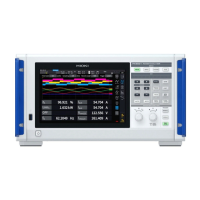234
Troubleshooting
Issue Cause
Solution and where to nd
additional information
Frequency cannot be
measured, or measured values
are unstable.
The input frequency is set outside
the range of 0.1 Hz to 2 MHz.
Check the frequency by viewing the
input waveform.
See “4 Waveform Display
Method” (p. 95).
The input frequency is lower than
the set frequency.
Set the measurement lower
frequency limit setting.
See “Measurement upper frequency
limit and lower frequency limit
(conguring frequency measuring
range)” (p. 61).
The synchronization source input
is incorrect.
The synchronization source input
range is too large.
Check the synchronization source
setting.
See “Synchronization source”
(p. 58),
“Voltage range and current range”
(p. 54)
A severely distorted waveform,
such as a PWM waveform, is
measured.
Set the zero-cross lter to [ON].
See “ZCF (Zero-cross lter)”
(p. 101).
Three-phase voltage
measurement results low.
Phase voltages are measured
with the
Δ
-Y conversion function.
Turn o the
Δ
-Y conversion function.
See “
Δ
–Y conversion” (p. 111).
Measured power values are
anomalous.
The instrument is incorrectly
connected.
Check the instrument’s connection.
See “2.9 Checking Connections”
(p. 49).
The rectier and LPF settings is
improperly congured.
Set the rectier properly.
If the LPF is enabled, set it to [OFF].
See “Rectication method” (p. 62).
“Low-pass lter (LPF)” (p. 60)
The current reading never falls
to zero even when receiving
zero-input.
A Universal Clamp On CT is used
with a lower current range.
The current sensor’s high-
frequency noise may be aecting
the current reading.
Perform zero adjustment after setting
the LPF to 100 kHz.
See “Low-pass lter (LPF)” (p. 60).
“2.8 Connecting Measurement
Leads and Sensors to Lines to Be
Measured” (p. 47)
The apparent power, reactive
power, and power factor
readings on the secondary-
side of an inverter dier from
measurements obtained using
other instruments.
Voltage values are higher than
expected.
The rectier settings are not
the same as those on the other
instruments.
Use the same rectier setting as with
the other instruments.
See “Rectication method” (p. 62).
The calculation methods dier. Use the same calculation methods
as with the other instruments.
See “5.6 Power Calculation Method”
(p. 113).
Motor RPM cannot be
measured.
The pulse output is set to other
than voltage output.
The instrument cannot detect
open collector pulse output.
Set the device to voltage output to
match the Ch. B pulse input setting.
The pulse output contains noise. Check the cable routing.
Ground the encoder that generate
the pulse output.
Specify the pulse noise lter (PNF).
See “Pulse noise lter (PNF)”
(p. 85).

